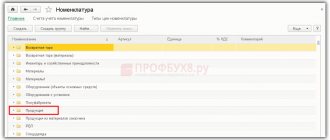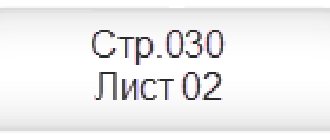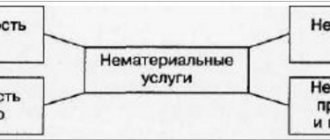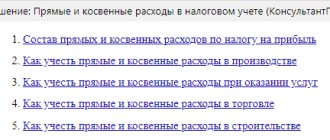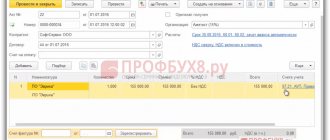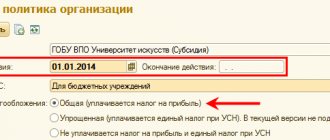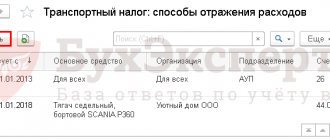If you are not familiar with the first two parts, you can find and read them using the links.
- 1C Accounting 8. Part 1: Setting up accounting parameters.
- 1C Accounting 8. Part 2: Accounting policies.
Income tax payers who are engaged in the production of products, performance of work and provision of production services need to divide production costs in 1C Accounting 8 into direct costs and indirect costs.
Methods for determining direct and indirect production costs in tax accounting of the 1C Accounting 8 program are described in the information register of the same name. The user must independently indicate in it a list of direct production costs in tax accounting 1C. The 1C program interprets everything that is not indicated in this register as indirect production costs.
Using specific examples, we will learn how to determine direct production costs in tax accounting in the 1C Accounting 8.2 program. It is very important that the distribution of direct expenses in 1C is handled by a person who knows accounting and tax accounting.
Direct and indirect production costs
Articles 271-273 of Chapter 25 of the Tax Code of the Russian Federation provide for income tax payers two alternative ways of determining income and expenses. The desired method must be fixed in the accounting policies of the organization.
- Accrual method . It is universal and suitable for all occasions.
- Cash method . Sometimes it is more convenient, but it has a number of limitations.
Payers of income tax are organizations that apply the general taxation system (OSNO). For these organizations, the 1C Accounting 8 program uses only the accrual method.
According to paragraph 1 of Art. 318 of the Tax Code of the Russian Federation, income tax payers who use the accrual method are required to maintain costs for the production and sale of goods (works, services), dividing them into direct and indirect costs. This is explained by different conditions for their recognition in tax accounting, see clause 2 of Art. 318 Tax Code of the Russian Federation.
- Indirect costs . Indirect costs of production and sales incurred in the current reporting (tax) period are fully recognized as expenses in the same tax period. That is, even if there was no sale in the current period, indirect expenses still reduce the taxable profit of this period.
- Direct expenses . Direct expenses refer to expenses of the current reporting (tax) period as products (works, services) are sold, in the cost of which they are taken into account in accordance with Article 319 of this Code. That is, taking into account the balance of work in progress.
An exception may be cases when an organization provides production services. Such taxpayers have the right to attribute the amount of direct expenses incurred in the reporting (tax) period in full to the reduction of income from production and sales of this reporting (tax) period without distribution to the balances of work in progress.
Subscribers to the ITS can find details of the recognition of direct and indirect expenses in the article “Production-related expenses” on the website of the Internet version of the ITS.
The list of direct expenses is not regulated by law. This means that the organization independently determines in its accounting policy the list of direct expenses, but taking into account the provisions of paragraph 1 of Art. 318 Tax Code of the Russian Federation.
- Material costs . Determined in accordance with paragraphs 1 and paragraph 4 of paragraph 1 of Art. 254.
- Labor costs . Expenses for remuneration of personnel involved in the production of goods, performance of work, provision of services, as well as expenses for compulsory pension insurance, used to finance the insurance and funded part of the labor pension for compulsory social insurance in case of temporary disability and in connection with maternity, compulsory medical insurance, compulsory social insurance against industrial accidents and occupational diseases, accrued on the specified amounts of labor costs.
- Depreciation . Amounts of accrued depreciation on fixed assets used in the production of goods, works, and services.
To separate direct and indirect costs in tax accounting in the 1C: Accounting 8 configuration, the information register “Methods for determining direct and indirect production costs in tax accounting” is intended.
But before studying it, open “ENTERPRISE\Chart of Accounts\ Chart of Accounts ” and pay attention to the following points. Those accounts on which tax accounting is maintained are marked with the sign of tax accounting - the presence of a flag in the “NU” column. The cost accounts (20, 23, 25, 26) also have a tax accounting feature. In addition, these accounts have a subaccount “Cost Items”.
In turn, cost items are described in the directory of the same name “Cost Items”. Among the details of this directory there is the attribute “Type of expense”. Its value is used for tax accounting purposes.
If the entire list of cost items could be divided into two non-overlapping lists (direct and indirect cost items), then it would be enough to simply create two corresponding directories and solve the problem of dividing costs into direct and indirect.
However, the difficulty is that the same cost item in some situations may relate to direct costs, in others to indirect costs. For example, a cost item with the expense type “Payroll”. This is a direct expense for remuneration of production personnel. But remuneration of management personnel is an indirect expense.
1C Accounting 8 edition 2.0 - Setting up a list of direct expenses
Start accounting - filling out the necessary reference books and entering initial balances is done manually.
Download data from 1C Accounting 8 - directories, balances at the beginning of the year, documents (if accounting does not start from the beginning of the year) are automatically transferred from the 1C Accounting 8 edition 1.6 program.
Download data from 1C Enterprise 7.7 - directories, balances at the beginning of the year, turnover for the period (if accounting does not start from the beginning of the year) are automatically transferred from the 1C Accounting 7.7 program.
Picture 1.
Regardless of the method of starting accounting, for all organizations under the general taxation system, it is necessary to configure the distribution of expenses in income tax accounting into direct and indirect.
In accordance with Article 318 of the Tax Code of the Russian Federation (TC RF)
, if the taxpayer determines income and expenses using the accrual method, then for income tax purposes, production and sales expenses incurred during the reporting (tax) period are divided into
direct and indirect
.
At the same time, the amount of indirect
production and sales expenses incurred in the reporting (tax) period are fully included in the expenses of the current reporting (tax) period.
Direct expenses refer to the expenses of the current reporting (tax) period as products, works, and services are sold in the cost of which they are taken into account.
In the 1C Accounting 8 edition 1.6 program, a separate Chart of Accounts for tax accounting is used for income tax accounting. In this Chart of Accounts, additional subaccounts are opened for all cost accounts (20.01, 23, 25, 26, 28, 29): 1 - direct expenses, 2 - indirect expenses. By choosing a specific subaccount of a given account in accounting, the accountant classifies expenses as direct and indirect.
In the 1C Accounting 8 edition 2.0 , accounting and income tax accounting is carried out using a “single” Chart of Accounts for accounting and tax accounting. Therefore, there was a need for additional settings to separate tax accounting expenses into direct and indirect. For this purpose, a register of information is used. Methods for determining direct and indirect production costs in tax accounting
.
This register of information is configured in the processing of Accounting policies of organizations
.
To access this information register, on the Income Tax tab there is a button Specify a list of direct expenses
.
If the register is not filled in, then when you press the button, the program offers to fill it automatically with entries that comply with the recommendations of Art.
318 Tax Code of the Russian Federation , see fig. 2. You can agree or refuse this proposal. For example, we will refuse and fill out the information register ourselves.
Figure 2.
This information register is intended to store a list of direct costs associated with the production of goods (performance of work, provision of services). It contains information about the rules for determining direct expenses in tax accounting. Moreover, this register must be filled out separately for each tax period. Therefore, when the new year begins, the program will offer to copy the rules from the previous period to the current one. In Fig. 3 shows an empty register of information Methods for determining direct and indirect production costs in tax accounting
.
Figure 3.
Each entry in this information register represents an accounting entry template. The following parameters are required to be filled in: Organization, Start date of the tax period and Type of expenses for tax accounting for income tax
.
When closing the month, the program compares accounting entries for accounts 20.01 Main production and 23 Auxiliary production
with these templates. If a suitable template is found, then income tax expenses are recognized as direct and included in the cost of goods, works, services, and if not, then they are recognized as indirect and included in current expenses (account 90). If some parameters in the template are not filled in, then they are not included in the comparison.
It must be recalled that these rules have nothing to do with the accounts 25 Manufacturing overhead, 26 General business expenses and 44 Selling expenses
, since expenses on these accounts in this program always relate to indirect expenses.
Let's turn to the Tax Code of the Russian Federation and create a list of direct expenses. In accordance with paragraph 1 of Art. 318 Tax Code of the Russian Federation
, direct costs may include, in particular:
- material costs determined in accordance with paragraphs. 1 and 4 paragraphs 1 art. 254 Tax Code of the Russian Federation
; - expenses for remuneration of personnel involved in the process of production of goods, performance of work, provision of services
, - the amount of accrued depreciation on fixed assets used in the production of goods, works, and services.
- material costs: raw materials and materials - 50,000 rubles
- production equipment – 2000 rubles
- production services - 10,000 rubles
- total - 62,000 rubles
- wages – 10,000 rubles
- insurance premiums - 2600 rubles other expenses (FSS NS and PZ) - 20 rubles
- depreciation – 1000 rubles TOTAL – 75620 rubles
In paragraph 1, paragraph 1 of Art. 254 (Material expenses)
The Tax Code of the Russian Federation talks about the costs of purchasing raw materials and (or) materials used in the production of goods (performance of work, provision of services).
In paragraph 4 of paragraph 1 of Art. 254 Tax Code of the Russian Federation
refers to the costs of purchasing components that undergo installation and (or) semi-finished products that undergo additional processing.
Consequently, not all material expenses are classified as direct expenses, but only those that go to account 20.01 from the credit of account 10.01 Raw materials and materials
and 10.02
Purchased semi-finished products and components
.
Let's formulate the rules, see Fig. 4.
Figure 4.
Consequently, wages accrued in the debit of account 20.01 relate entirely to direct costs. Let's create one more rule. See Figure 5.
Figure 5.
as well as expenses for compulsory pension insurance, compulsory social insurance in case of temporary disability and in connection with maternity, compulsory medical insurance, compulsory social insurance against industrial accidents and occupational diseases, accrued on the specified amounts of labor costs;
Thus, all insurance premiums accrued on the debit of account 20.01 can also be classified as direct costs.
To account for FSS NS and PP, the program must use cost items with the type of expense in NU - Other expenses. Other expenses vary. Therefore, let us clarify the rule with credit account 69.11 Calculations for compulsory social insurance against industrial accidents and occupational diseases
.
Figure 6.
Consequently, only depreciation of fixed assets accrued in the debit of account 20.01 relates to direct expenses. Therefore, we will select the loan account 02.01 Depreciation of fixed assets accounted for in account 01
.
Figure 7.
As a result of our actions, we have compiled a list of direct costs recommended by Art. 318 Tax Code of the Russian Federation. See rice. 8.
Figure 8.
Auxiliary production in its accounting
, you need to create records for this account as well.
For example, consider the economic activities of our organization
in January 2010.
For the production of garments in the Sewing Shop
according to the document
Request-invoice,
the material was transferred -
of woolen material
in the amount of 50,000 rubles in accounting and tax accounting. In accordance with our income tax accounting policy, the cost of raw materials and materials is classified as direct expenses.
Figure 9.
The wages of seamstress-motorist Maria Petrovna Petrova
in the amount of 10,000 rubles. In accordance with our accounting policy, remuneration of production personnel is classified as direct expenses.
Figure 10.
To pay production workers, insurance premiums and Social Insurance Fund for National Insurance and Labor Protection were assessed in the amount of only 2,620 rubles. In accordance with our accounting policy, insurance premiums accrued for wages of production personnel are classified as direct expenses.
Figure 11.
Depreciation of 1000 rubles was accrued on fixed assets used for the production of garments. In accordance with our accounting policy, depreciation of production fixed assets is classified as direct expenses.
Figure 12.
Production equipment worth 2,000 rubles was transferred to the workshop. The cost of inventory is not a direct expense.
Figure 13.
Production services from a third party organization in the amount of 10,000 rubles were credited to account 20.01. Costs of production services are not considered direct costs.
Figure 14.
And finally, the workshop produced finished products, which were received at the Main warehouse
at a planned cost of 40,000 rubles. The planned cost is reflected in the credit of account 20.01.
Figure 15.
Thus, we took into account on account 20.01 the actual costs in accounting and tax accounting in the amount of 75,620 rubles, of which:
The planned cost of manufactured products is 40,000 rubles, therefore in January our organization experienced an overexpenditure of 35,620 rubles (75,620 actual minus 40,000 plan). Closing the month should bring the cost of our products to the actual cost, that is, add additional charges to the account 43 Finished products
overexpenditure (close account on 20.01).
We will perform the processing Closing the month
for January.
The closing of account 20.01 is carried out by the regulatory operation Closing accounts
20, 23, 25, 26. See fig. 16.
Figure 16.
The postings of this regulatory operation regarding the closure of the account on January 20 for accounting and tax accounting are presented in Fig. 17.
Figure 17.
In accounting, the amount of overexpenditure of 35,620 rubles was written off from the credit of account 20.01 to the debit of account 43 and thereby formed the actual cost of finished products in accounting.
In tax accounting, the closure of the account on January 20 was divided into two parts. Direct expenses in terms of overexpenditure of 23,620 rubles (63,620 - 40,000) were written off to account 43 and formed the actual cost of finished products in tax accounting. Simultaneously on the debit of account 43 and the credit of account 20.01 for accounting in accordance with PBU 18/02 Calculation of corporate income tax
a temporary difference in the amount of 12,000 rubles is taken into account (BU (35620) – NU (23620)).
Indirect expenses in the amount of 12,000 rubles were written off from the credit of account 20.01 to the debit of account 90.08.1 Administrative expenses for activities with the main taxation system
, and also on the debit of account 90.08.1 and the credit of account 20.01, a temporary difference of -12,000 rubles is taken into account (BU (0) - NU (12000)).
As a result, we received different costs of finished products in accounting and tax accounting. Let's look at the balance sheet for account 43 for the month of January. Using the Settings
For clarity, we will select three indicators: BU, NU and VR. See fig. 18.
Figure 18.
The report shows the actual cost of finished products in accounting, tax accounting, as well as the amount of temporary differences of 12,000 rubles.
Let's return to PBU 18/02. Temporary differences in the account credit on January 20 in the amounts of 12,000 and -12,000 compensated for each other.
When calculating deferred tax assets and liabilities, temporary differences in accounts 25, 26, 90, 91 and 99 are not taken into account.
But the temporary difference of 12,000 in the debit of account 43 will lead to the recognition of a deferred tax liability
in the amount of 2400 rubles (BP (12000) * STnp (20%)).
In Fig. Figure 19 shows the posting of a regulatory operation Calculation of income tax
processing
Closing the month
for January.
Figure 19.
Since we have different product costs in accounting and tax accounting, the costs of selling these products will be different. Figure 20 shows the postings of the document Sales of goods and services
in February 2010.
As we can see, expenses in the debit of account 90.02.1 Cost of sales for activities with the main tax system
in accounting are 75,620 rubles, and in tax accounting are 63,620 rubles.
Figure 20.
Along with the write-off of finished products, temporary differences are also written off from the credit of account 43. If we sell all our products in February, then the temporary differences will be written off completely and the deferred tax liability will be paid off at the end of the month. See fig. 21.
Figure 21.
If an accountant does not want to distinguish between accounting and tax accounting, then he needs to improve his accounting policies for tax accounting.
In accordance with Art. 318 Tax Code of the Russian Federation
, the taxpayer independently determines in the accounting policy for tax purposes a list of direct expenses associated with the production of goods (performance of work, provision of services).
Required in the information register Methods for determining direct production costs
in tax accounting, add rules for production inventory and production services.
Figure 22.
If such rules are added, then closing the account on January 20 in accounting and tax accounting will be identical, and temporary differences will not arise. See fig. 23.
Figure 23.
The generated actual cost of finished products for accounting and tax accounting can be seen in the balance sheet for account 43 for January 2010. See fig. 24.
Figure 24.
To control income tax accounting, it is convenient to use the report Register of Production Expenses.
.
It is located in the Reports
in the submenu
Tax accounting registers for income tax
.
The register is intended to determine the amount of direct costs for the production of products (works, services) and indirect costs of the current period.
When generating the report, direct or indirect expenses are selected; by clicking the Settings button, you can select the types of expenses of interest. See fig. 25.
Figure 25.
Register of information “Methods for determining direct and indirect production costs in tax accounting”
We have already noted above that to resolve this problem, a periodic register of information “Methods for determining direct and indirect production costs in tax accounting” has been introduced into the configuration.
It is not uncommon to hear the following phrase. This register contains a list of direct expenses. All costs that are not described in it are indirect costs. This is not entirely true. It does not contain a list of direct expenses, but a list of rules (conditions) for determining direct expenses. Each entry is a condition. If at least one condition described in the register is met for an expense, then such expense is recognized as a direct expense in the program. For those expenses for which none of the conditions are met, they are indirect expenses.
Often entries in this register are called patterns or masks. It is possible that all this is not very clear yet. So let's take it in order.
The organization independently approves the list of direct expenses in its accounting policies. Therefore, it is best to register it through the information register form “Accounting Policies of Organizations”. Go to the “Income Tax” tab and click on the “Indicate a list of direct expenses” button.
If for a given organization the information register “Methods for determining direct and indirect production costs in tax accounting” does not yet contain a single entry, then the program will offer to fill it out automatically.
You don’t have to think long about choosing a button. After approximately 20 seconds, the program will open the register for manual generation of the necessary entries in it. In principle, you can close it and click on the “Specify list of direct expenses” button again.
Don’t be surprised if, when you open this register using the command “OPERATIONS \ Information Register \ Methods for determining direct and indirect production costs in tax accounting,” the program does not prompt you to fill it out. In this mode, it doesn't really offer to fill it out.
After clicking on the “Yes” button, the register will be filled with the following entries.
Each entry in this register represents a condition for recognizing an expense as a direct expense. The actual division of expenses in tax accounting into direct and indirect is made at the end of the month by the regulatory document “Closing accounts (20, 23, 25, 26).”
Using the example of the 1st entry, let’s see how the document “Closing accounts (20, 23, 25, 26)” “reasons” to recognize the expense as direct or indirect. In a simplified way, we can distinguish the following stages of “making” a decision.
- 1st step . For the current month (for example, March 2012), for the organization “Trading house “Complex”, in the accounting register “Journal of entries (accounting and tax accounting)” the document finds all records (accounting entries) of type 20.01\69.11.
- 2nd step . Among the found records, only those whose date is not earlier than the date of the template in the register “Methods for determining direct and indirect production costs in tax accounting” remain for further analysis. In our example, this is 01/01/2012.
- 3rd step . Since the “Division” attribute is not specified in the register template, the entries 20.01\69.11 made in any division of the organization are considered below.
- 4th step . The item “Cost Item” is also not filled in, but this does not mean that any cost items are being considered. Only those cost items that have the value “Other expenses” indicated in the “Type of expense” attribute are taken into account. Why is that? Yes, because in the entry in question, in the “Type of expenses NU” detail, the value “Other expenses” is indicated.
Thus, if the entry 20.01\69.11 made in accounting satisfies all the listed conditions, then the program will classify its amount as direct expenses.
If an expense is detected in accounting for which no suitable template is found in this register, then in tax accounting this expense is recognized as indirect and its program writes it off as a debit to the corresponding subaccount of account 90.08 “Management expenses”.
Now let’s take a closer look at the details of the information register “Methods for determining direct and indirect production costs in tax accounting.” It contains two groups of details: Mandatory and Additional.
Required details.
- Date . Here we indicate the date from which this register entry is valid. If over time the accounting policy for the list of direct expenses changes, then it will be necessary to enter new entries with new dates of their activity.
- Organization . Each organization independently determines its own list of direct expenses. Since direct expenses are stored in this register for all organizations, for each entry it is necessary to indicate its affiliation with a particular organization.
- Type of expenses in NU . Type of consumption in accordance with the classifications in paragraph 1 of Art. 318 Tax Code of the Russian Federation. The choice of expense type in NU limits the list of possible cost items. For this record, only those cost items can be considered that have the same value indicated in the “Type of expense” attribute as in the “Type of expense in NU” attribute.
Additional (optional) details.
- Division . We indicate the division for which, in accordance with the adopted accounting policy, the costs are direct. Typically these are production units. If a department is not specified, then costs for all departments are considered.
- Account Dt . If necessary, you can specify any of 4 cost accounts: 20, 23, 25 or 26. If the account is not specified, then any of these accounts is assumed by default.
- Kt account . If necessary, you can indicate any account that corresponds in debit with the cost account in accordance with the Instructions for using the Chart of Accounts (Order 94n).
- Cost item . The program will allow you to indicate only that cost item for which the value of the “Type of expense” attribute coincides with the value of the attribute “Type of expense in NU” in the information register in question.
It is very important to understand that until the end of the month, the organization’s production costs are not divided into direct and indirect costs. In accordance with the settings of the Chart of Accounts, they are reflected as expenses at the time of registration of a business transaction in accounting (AC) and in tax accounting (TA).
It is equally important to understand, depending on what settings, certain postings occur in the control unit and in the control unit. For clarity, consider the following example. Let the document “Request-invoice” write off materials to account 26 “General business expenses”. Let also, for the sake of simplicity, in the information register “Methods for determining direct and indirect production costs in tax accounting” there is not a single entry. That is, all expenses in tax accounting are recognized as indirect. After closing the month, depending on the accounting policy settings, we will see the following transactions.
Option 1: The “Direct costing method” flag is cleared.
- BU: 26\10.01 , the posting is generated by the “Request-invoice” document in accordance with the settings of the information register “Item Accounting Accounts”.
- NU: 26\10.01 , the posting is generated by the document “Request-invoice” in accordance with the settings of the information register “Item Accounting Accounts” and the presence of the sign of maintaining NU on account 26 “General expenses” and account 10.01 “Raw materials and materials”.
- NU: 90.08.1\26 , the posting is generated by the document “Closing accounts (20, 23, 25, 26). In our setting, all costs are indirect.
Pay attention to the last posting, 90.08.1\26. It has nothing to do with the state of the “By direct costing” flag. It is due to the fact that there is not a single entry in the information register “Methods for determining direct and indirect production costs in tax accounting.” This means that all expenses in NU are recognized as indirect and are written off at the end of the month to account 90.08.1.
Option 1: The “By direct costing method” flag is set.
- BU: 26\10.01 , the posting is generated by the “Request-invoice” document in accordance with the settings of the information register “Item Accounting Accounts”.
- BU: 90.08.1\26 , the posting is generated by the document “Closing accounts (20, 23, 25, 26), if the flag “By the direct costing method” is set.
- NU: 26\10.01 , the posting is generated by the document “Request-invoice” in accordance with the settings of the information register “Item Accounting Accounts” and the presence of the sign of maintaining NU on account 26 “General expenses” and account 10.01 “Raw materials and materials”.
- NU: 90.08.1\26 , the posting is generated by the document “Closing accounts (20, 23, 25, 26). In our setting, all costs are indirect.
From the analysis of this example, attention should be paid to the following point.
The state of the flag “By the direct costing method” affects the formation of transactions only in accounting when closing the month. It has nothing to do with tax accounting
In tax accounting, the write-off of expenses as cost or administrative expenses is determined by their nature. Direct expenses at the end of the month are written off from expense accounts to the debit of account 90.02.1 “Revenue from activities with the main taxation system.”
On the contrary, indirect expenses when closing the month are directly debited to account 90.08.1 “Administrative expenses for activities with the main taxation system.”
How to set up the order of distribution of indirect expenses?
In order to set up the procedure for distributing indirect expenses in accounting, you need to open the “Accounting Policy” information register. There are no separate settings for the distribution of these expenses in tax accounting; they are distributed according to the same rules as in accounting:
- Section: Main – Accounting policies.
- In the block “Types of activities for which the costs are accounted for on account 20 “Main production”” you need to check the box “Product output” and (or) “Performance of work, provision of Methods for distributing indirect costs” (for general production and general business expenses) and the cost calculation block.
- If the switch “General business expenses are included” is set to the position “In the cost of sales (direct costing)”, then the expenses recorded on account 26 will not be distributed.
- Using the link “Methods for the distribution of indirect expenses”, you need to open the form “Methods for the distribution of general production and general business expenses” and configure the distribution order:
- In the “Period” field, specify the date from which the setting is effective.
- Select the cost account for which the rules are set. If the account is not specified, then the rules apply to both accounts for accounting for indirect expenses (25 “General production expenses” and 26 “General expenses”).
- In the “Distribution base” field, indicate the distribution base for indirect costs:
- “Volume of output” (distribution occurs in proportion to the volume of products produced in the current month, work performed and services provided, expressed in quantitative measures).
- “Planned cost of production” (distribution is carried out in proportion to the planned cost of products produced in the current month, work performed and services rendered (distribution is carried out in proportion to the amounts of direct costs for items with the type “Payment”).
- “Material costs” (distribution is carried out in proportion to the amounts of direct costs for items with the type “Material costs”).
- “Revenue” (distribution is carried out by product groups in proportion to revenue from products sold, work performed, (distribution is carried out in proportion to the amounts of direct costs reflected in accounts 20 and/or 23. For tax accounting purposes, indirect costs reflected in accounts 20 are excluded from the distribution base and 23).
- “Individual direct cost items” (distribution occurs in proportion to the amounts of direct costs for the items specified in the “List of cost items” field). 8) "Not distributed." There is no automatic allocation of indirect costs.
- The distribution method can be established with an accuracy of the division and cost item.
- “Save and close” button.
Analysis of direct and indirect production costs
To analyze direct and indirect costs of production (work, services), ordinary standard accounting reports are suitable. It is only important to remember the following.
The division into direct and indirect expenses is carried out by the regulatory document “Closing accounts (20, 23, 25, 26)”. Therefore, information about expenses in tax accounting in standard accounting reports can only be obtained after posting this document. We will focus on specialized reports.
Report “Register of accounting for production costs”.
This report can be opened using the command “REPORTS\Tax accounting registers for income tax\ Production expenses accounting register ”. Depending on the value of the “Type of expenses” attribute, it generates a list of direct or indirect expenses.
Let us immediately note that the list of direct expenses in this report is only potential direct expenses for now. Some of them will become so only after implementation. Remember “direct expenses relate to the expenses of the current reporting (tax) period as products (works, services) are sold ...”, Art. 318 Tax Code of the Russian Federation.
Indirect expenses in tax accounting are recognized as they arise. That is, there is no need to wait for the products to be sold. Their list can be seen if you indicate “Indirect expenses” in the “Type of expenses” detail.
The report “Register of accounting for production costs” can be generated both before and after the regulatory document “Closing accounts (20, 23, 25. 26”).
Report “Analysis of the state of tax accounting for income tax.”
After completing the document “Closing accounts (20, 23, 25. 26,” the data from the report “REPORTS \ Analysis of the state of tax accounting for income tax " becomes relevant. It allows you to analyze direct and indirect taxes that went to reduce the tax base for income tax .
The report can be generated only if there were income, or more precisely sales, for the specified period.
Click on the "Expenses" section. A form will open in which you can see the amounts of direct and indirect expenses recognized in tax accounting.
Let's analyze it. And so, the report shows that the program recognized direct expenses in the amount of 30,720 rubles. However, we saw above that direct expenses should be twice as much - 61,440 rubles. The reason is that we used exactly two chairs worth of materials for production. They also released two chairs. But they sold one chair. And direct costs, as we remember, are accepted as products are sold.
You can further drill down into the report data by clicking on the appropriate accounting sections. But we'll move on to other reports.
Help-calculation “Product cost”.
This report can be opened using the command “REPORTS\References-calculations\ Cost of products ”. It allows you to display the actual cost of production, both in accounting and tax accounting.
The printed form of the report is an accounting document. It approves the distribution of production costs into the cost of manufactured products and the cost of services provided in the month the report is generated.
Help-calculation "Calculation".
This report can be opened using the command “REPORTS\Calculation references\ Calculation ”. It allows you to display the composition of expenses that formed the actual cost of production, both in accounting and tax accounting.
The printed form of the report is an accounting document. It approves the composition, quantitative and monetary characteristics of the costs for the production of manufactured products and the provision of production services in the month the report is generated.
Registration
Direct expenses are reflected in the register for recording direct expenses that reduce taxable profit.
For information on how to fill it out, see the section “Industry specifics of accounting for income and expenses” → subsection “Tax accounting in production.
Indirect (other) expenses are reflected in the consolidated register of accounting for other expenses of the current period. It is filled out on the basis of data from other tax registers about the company’s expenses that are classified as other (for example, a register for accounting for expenses for warranty repairs; a register for accounting for settlements with the budget, etc.).
Data from these registers is transferred to the income tax return.
Each type of indirect costs (wage costs, information and consulting services, etc.) is indicated separately in the register.
The following table will help you fill out the consolidated register for accounting for indirect expenses and transfer the data to the income tax return:
| Type of consumption | Register | Income tax return line |
| Direct expenses (Appendix 2 to sheet 02 of the declaration) | ||
| Direct costs, processing and processing of raw materials | Register for recording direct expenses that reduce taxable profit | 010 |
| Direct costs for work and services | Register for recording direct expenses that reduce taxable profit | 010 |
| Direct expenses of trading companies | Register for recording direct expenses that reduce taxable profit | 020 |
| Indirect expenses (Appendix 2 to sheet 02 of the declaration) | ||
| Purchase of works or services | Register of accounting transactions for the acquisition of property, works, services, rights | 040 |
| Remuneration, including: | Labor cost accounting register | 040 |
| – general business and non-production personnel | Labor cost accounting register | 040 |
| – expenses for voluntary insurance (medical and pension) | – Register of contracts for voluntary insurance of employees – Register of cost accounting for voluntary insurance of employees – Register-calculation of accounting expenses for employee insurance of the current period | 040 |
| Amounts of accrued depreciation on fixed assets for general purposes | – Register of information about fixed assets – Register-calculation of depreciation of fixed assets | 040 |
| Other expenses, total | – Register of accounting transactions for the acquisition of property, works, services, rights – Register of accounting for other expenses of the current period | |
| Taxes and fees | – Register for accrual of taxes and fees – Register of accounting of settlements with the budget | 041 |
| Legal, information and consulting services | Register of accounting transactions for the acquisition of property, works, services, rights | 040 |
| Expenses for company management services | Register of accounting transactions for the acquisition of property, works, services, rights | |
| Entertainment expenses | Register of accounting transactions for the acquisition of property, works, services, rights | 040 |
| Advertising expenses | Register of accounting transactions for the acquisition of property, works, services, rights | 040 |
| Other expenses | Register of accounting transactions for the acquisition of property, works, services, rights | 040 |
| Price of other property sold and costs of its sale | Register for recording the cost of sold other property | 060 |
| Residual value of sold depreciable property and expenses for its sale | Register-calculation “Financial result from the sale of depreciable property” | 060 |
| Expenses of service industries and farms | Register-calculation “Financial result from the activities of service industries and farms” | 080 |
| Losses from the sale of depreciable property | Register-calculation “Financial result from the sale of depreciable property” | 100 |
| Losses of service industries and farms (housing, communal and socio-cultural facilities) in previous years | Register of losses of service industries and farms | 090 |
| Travel expenses | Register of accounting transactions for the acquisition of property, works, services, rights | 040 |
| Audit costs | Register of accounting transactions for the acquisition of property, works, services, rights | 040 |
| Costs of providing company employees to third parties | Register of accounting transactions for the acquisition of property, works, services, rights | 040 |
| Expenses for training and retraining of personnel | Register of accounting transactions for the acquisition of property, works, services, rights | 040 |
| Expenses for market research | Register of accounting transactions for the acquisition of property, works, services, rights | 040 |
| Periodic payments for the use of rights to the results of intellectual activity | Register of accounting transactions for the acquisition of property, works, services, rights | 040 |
| Employee insurance costs | – Register of cost accounting for voluntary insurance of employees – Register-calculation of accounting expenses for employee insurance of the current period | 040 |
| Remuneration of management employees | Register of labor costs accounting | 040 |
| Additional employee benefits provided for in the employment contract | Register of labor costs accounting | 040 |
| Depreciation of fixed assets and intangible assets | – Register of information about fixed assets – Register-calculation of depreciation of fixed assets – Register of information about the object of intangible assets – Register-calculation of depreciation of intangible assets | 131 |
| Amortization of intangible assets | – Register of information about the object of intangible assets – Register-calculation of depreciation of intangible assets | 132 |
